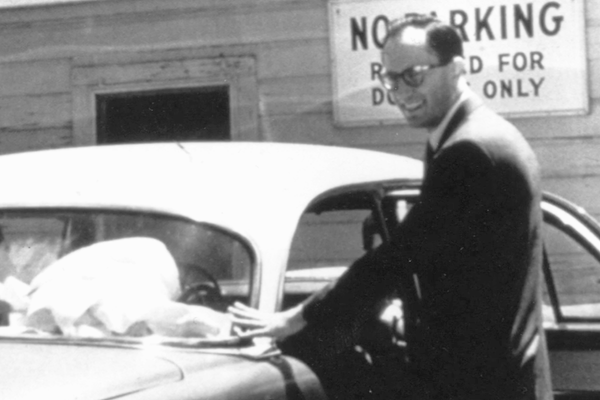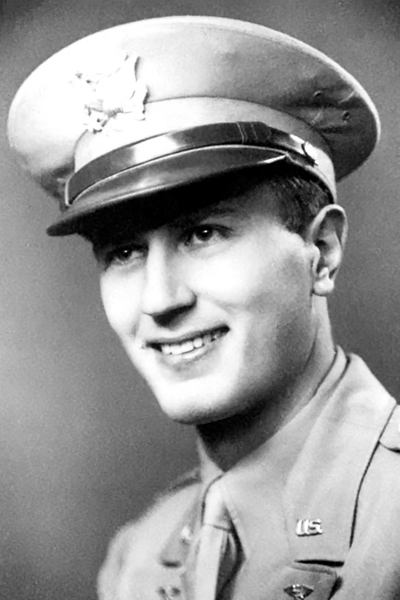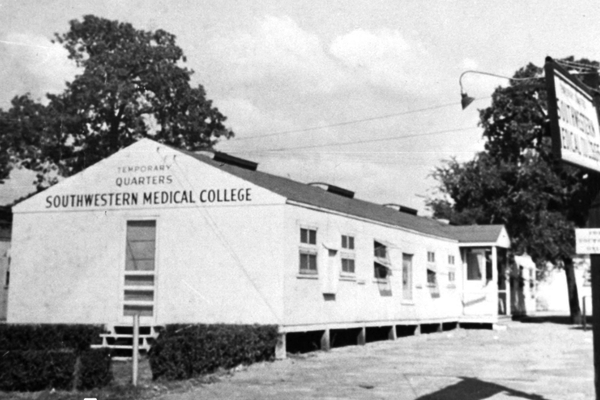The Seldin Era (1951–1987)

When Donald W. Seldin first arrived in Dallas in 1951, he expected to find a medical school befitting its name. Instead, he encountered a scene that could have been lifted from a Depression-era photograph: a handful of wooden shacks clustered behind a crumbling brick building, floors strewn with garbage, and a railway overpass looming nearby. “I didn’t see anything that looked like a medical school,” he later recalled. “That’s it,” a gas station attendant told him when he asked for directions.
Dr. Seldin had come from Yale University, where he was an Assistant Professor of Medicine, and the contrast could not have been starker. Yet in that moment of disillusionment, he made a decision that would alter the course of UT Southwestern, and American academic medicine. He stayed.

Early Influences
Before arriving in Dallas, Dr. Seldin had served as a captain in the U.S. Army Medical Corps, so he was accustomed to training in adverse conditions. As Chief of Medicine at the 98th General Hospital in Germany between 1946 and 1948, he was summoned to Dachau to testify at the trial of a Nazi physician accused of conducting lethal human experiments on 40 prisoners. The defendant, who had trained at The Rockerfeller University, chose to represent himself. Dr. Seldin testified for three days; the physician was found guilty and sentenced to death. In later years, Dr. Seldin spoke often about the profound impact of the experience, resulting in a lifelong commitment to medical ethics.


The early days were daunting. Within six months of his arrival, the Department’s second chair, Charles Burnett, announced he was leaving for the University of North Carolina. Other key faculty soon followed, leaving Dr. Seldin virtually alone amid the shacks and the old Parkland Hospital. “Looking around, there was the garbage, the shacks, the wasteland,” he said. But where others saw failure, Dr. Seldin saw possibility. He understood the department’s greatest asset wasn’t its buildings, it was its students.
With no resources to lure established stars, Dr. Seldin devised a bold strategy: He would send the brightest students to the nation’s premier research institutions, then bring them back to Dallas. Over the next few years, he dispatched future giants like Jean Wilson, Jere Mitchell, Daniel Foster, and Norman Kaplan to the National Institutes of Health for advanced training. They returned, as promised, and became the backbone of a faculty that would transform UT Southwestern into a world-class center of medicine.

Dr. Seldin’s vision extended beyond recruitment. He imagined a department where faculty were not only clinicians but also physician-scientists who made ward rounds and pursued research with equal vigor. He cultivated a culture of intellectual rigor and collegiality, where ideas flowed freely and ambition was matched by collaboration. “We developed a warm relationship throughout the Department,” he said, describing an esprit de corps that became UT Southwestern’s hallmark.
His efforts attracted established talent and as well, including rheumatologist Morris Ziff and cholesterol expert Marvin Siperstein, and laid the groundwork for discoveries that would change medicine. Many of the students and faculty he recruited became leaders in their various specialties, including nephrologists Floyd Rector and Roland Blantz, gastroenterologists John Fordtran and John Dietschy, and rheumatologist and lupus expert Evelyn Hess. Among his most prescient moves was encouraging a gifted medical student, Joseph Goldstein, to pursue genetics training and return to Dallas. Dr. Goldstein returned, bringing with him Michael Brown. Together, they unraveled the mysteries of cholesterol metabolism, earning the Nobel Prize and cementing UT Southwestern’s place on the global scientific stage.



Dr. Seldin also revolutionized medical education. As the first Director of the Internal Medicine Residency program and the first Director of the Nephrology Fellowship program, he minimized lectures and emphasized small-group teaching on the wards, ensuring students learned medicine at the bedside, guided by faculty who were both clinicians and researchers. His approach produced generations of physicians whose influence extended far beyond Dallas. Today, the Internal Medicine residency is among the largest programs in the nation.
After 38 years as chair (one of the longest tenures in American medical history), Dr. Seldin stepped down in 1987. Reflecting on his legacy, he said, “The greatest satisfaction I have is the students, house staff, and fellows who have left the department and been distinguished in both academic medicine and clinical practice.” From a handful of shacks to a thriving academic powerhouse, Seldin had not only built a department, he had created a model for excellence that endures to this day.
